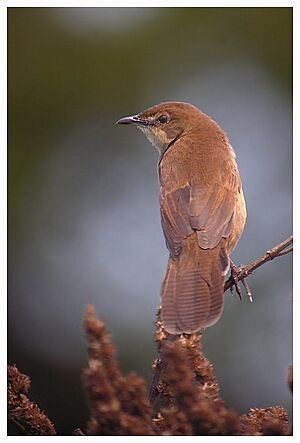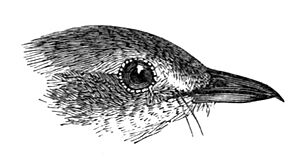Broad-tailed grassbird facts for kids
Quick facts for kids Broad-tailed grassbird |
|
|---|---|
 |
|
| In Brahmagiri Wildlife Sanctuary, Karnataka, India | |
| Conservation status | |
| Scientific classification | |
| Genus: |
Schoenicola
|
| Species: |
platyurus
|
| Synonyms | |
|
Timalia platyura |
|
The broad-tailed grassbird (Schoenicola platyurus) is a small bird found mainly in the Western Ghats of India. It might also be found in Sri Lanka. This bird is mostly brown and has a special broad, rounded tail.
It lives in grassy hills at higher altitudes. Usually, it stays hidden in the grass. But during its breeding season, the males fly up high to sing. This bird is thought to live in one place all year. However, it might move around locally sometimes.
What Does It Look Like?
This bird is easy to spot because of its unique tail. Its upper body is a plain brown color. The tail is broad, rounded, and has feathers that get longer towards the end. It also has a light brown stripe above its eye. The brown tail has thin dark stripes. The underside of its tail is very dark with white tips on the feathers.
Male and female broad-tailed grassbirds look the same. When a male sings during breeding, it makes a sound like a lark. It's a repeated trill. While singing, it fans its tail and flutters its wings. Other sounds it makes include a "chack" and a "zink" noise. The inside of the male's mouth is black when it sings. Females have brown mouths.
When it's not breeding season, this bird likes to hide. It moves quickly through grass and reeds. Sometimes, you might see it perching out in the open.
Where Does It Live?
The broad-tailed grassbird lives in moist, grassy highlands. It is mainly found in the Western Ghats of southern India. There are records of it living south of Karnataka. Some birds have also been seen in Pune, Lonavala, and Nasik.
One bird was found at Point Calimere. This suggests that these birds might move around or migrate locally. They could possibly even go into Sri Lanka. However, there isn't strong proof that they live in Sri Lanka. There are only a few old sightings and one old specimen.
How Does It Behave?
The broad-tailed grassbird usually breeds from March to May. But nests have also been seen in July and September. This means they might raise two groups of young birds each year.
The nest is shaped like a ball. It's made of rough grass blades and has an entrance on the side. The bird builds its nest low down in a clump of tall grass. The eggs are white with brownish-red spots. A female usually lays 2 or 3 eggs. These birds eat insects.



